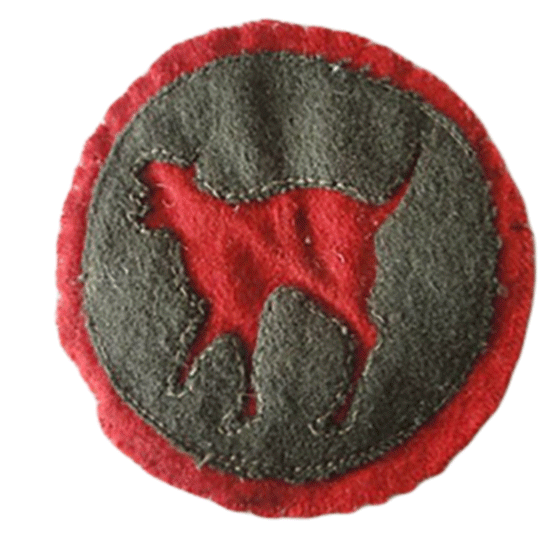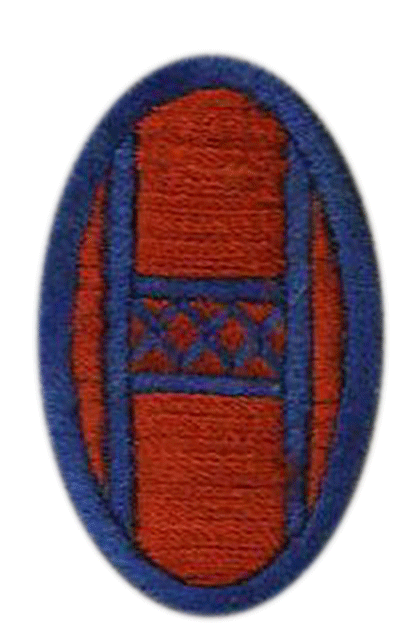Where Did the Shoulder Sleeve Insignia Come From?
One of the most distinctive parts of a Soldier’s uniform is the shoulder patch. The Shoulder Sleeve Insignia (SSI) not only functions as a means of identifying a Soldier’s unit, but is also a key element to building unit morale and esprit de corps. The unit patch often tells the story of a unit’s history and culture. It is proudly worn as a symbol of unit esteem. Ironically, this small item that now serves as an expression of Soldier unity was born out of an act of insubordination.
In April of 1917, the United States joined the international battles of World War I (WWI), declaring war on Germany and allying with France and England. Unfortunately, the United States was wholly unprepared. The U.S. Army had less than 200,000 Soldiers serving, including both the Army National Guard and active duty – it needed millions.
Within 18 months, the U.S. Army would grow to a force of over four million troops with two million serving in France by the war’s end on Nov. 11, 1918. These massive numbers made it difficult for commanders to identify their troops and identify unit equipment and baggage when traveling overseas. With the expansion of the Army’s size, most units were also built from scratch, having no history or bond to foster esprit de corps. To fix these issues, division commanders were inspired to give their units distinctive names and insignias to classify their troops and to bring their units together under a common point of pride.
One of the first U.S. divisions to do this was the 81st, a “National Division” formed at Camp Jackson, South Carolina, in August 1917. It was predominantly comprised of draftees from the southeastern part of the country. MG Charles J. Bailey, the division commander, noticed that a few other units were developing logos, slogans and mottos to put on buildings, gear and equipment. He liked the idea and challenged his Soldiers to develop a name for the division. Originally, the division adopted the nickname “Stonewall Division” in honor of Confederate Gen. Thomas “Stonewall” Jackson – mainly because of the unit’s large number of southern inductees. That name, however, did not last long. Soon after the adoption of Stonewall Division, one of the Soldiers made a logo modeled after a Carolina wildcat they had captured near Wildcat Creek during division training. The wildcat was so popular among the troops that the Stonewall nickname was dropped and changed to the Wildcat Division. The cat became the division mascot and the logo was approved.

MG Bailey then took things a step further than any other division. He tasked his command with developing a distinctive shoulder patch to be worn on the Soldiers’ uniforms. They designed a circular patch with the wildcat image in the center. After approving the design, MG Bailey assigned different colored patches to his subordinate units. He then – on his own authority – authorized his Soldiers to wear the patches on their left sleeve, and later, on their overseas cap.
That decision quickly drew criticism from higher command due to the clear violation of Army uniform regulation. MG Bailey was ordered to remove the patches from his Soldiers’ uniforms, but he defied that order and the Wildcat Division continued to wear their patches. For months, MG Bailey fought the order through official channels. Finally, GEN John Pershing, commander of the American Expeditionary Forces, relented and not only allowed the 81st Division patch, but also authorized every other U.S. Army division to submit a patch design for review, approval and wear.
On October 19, 1918, MG Bailey’s 81st Division was the first to submit their design, which received official approval the same day. It would become the first U.S. Army division to receive authorization for its Soldiers to wear an SSI on their uniforms.
Many other Army divisions followed the lead of the 81st, including National Guard Divisions. Here are just a few examples of the current National Guard SSIs that originated in WWI:
29th Division
- SSI approved December 14, 1918
- Comprised of Guard units from Maryland, Virginia and New Jersey
- Nicknamed “The Blue and the Grey” because the Division was made up of men that fought on both sides of the Civil War

30th Division (now 30th Brigade Combat Team)
- SSI approved October 23, 1918
- Comprised of Guard units from Tennessee, North Carolina and South Carolina
- Nicknamed the “Old Hickory Division” in honor of Andrew Jackson, the first bearer of the Old Hickory nickname

35th Division
- SSI approved October 29, 1918
- Comprised of Guard units from Kansas and Missouri
- Nicknamed the “Santa Fe Division” in remembrance of the Santa Fe Trail, where the unit trained

By Contributing Writer MAJ Darrin Haas



